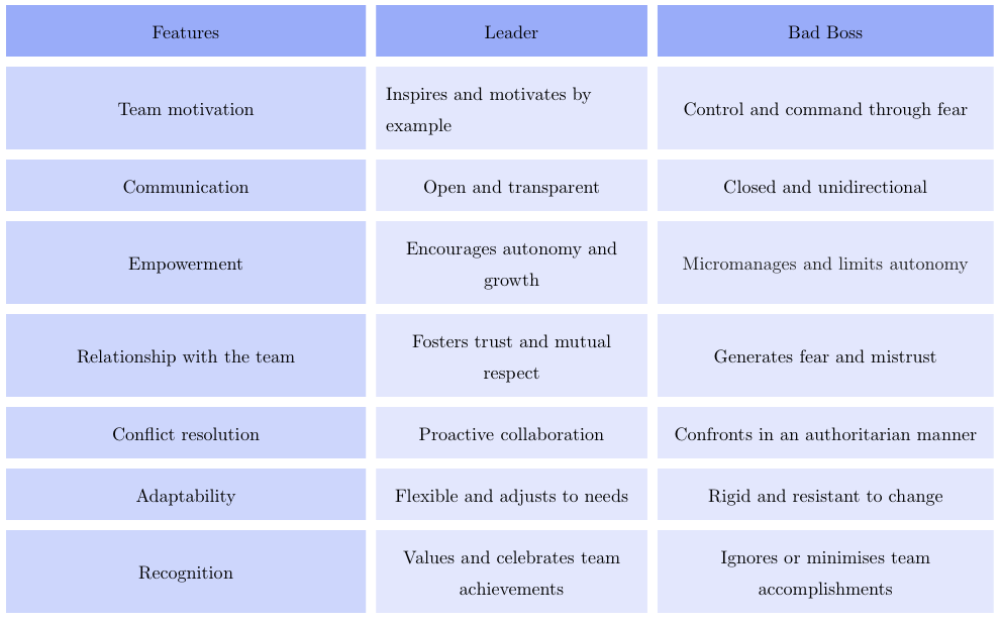It's very funny how most people lose their tongues, and we can catch them red-handed when they're not doing things right. What is repeated most often is to see this whole bunch of characters who believe themselves to be good leaders and are nothing more than bad bosses. Those who realise it, have a hard time—those who do not, have a worse time.
In the field of talent management, it is essential to understand the differences between a leader and a bad boss, as these figures have a significant impact on the motivation, productivity, and well-being of work teams. Although often confused, the roles of a leader and a boss can differ drastically in their approaches and in the way they influence their subordinates. The boss is troubled because they lose control of the processes and of their work team, and they do not know how to exploit talent. They wants to fill those gaps with intimidating practices. We know what I mean.
Leaders inspire their work teams to achieve common goals through accompaniment and example. Leaders not only focus on results, but also on the development and well-being of the people under their charge. They have the ability to motivate, listen, and adapt their management style to the needs of their team. It fosters a positive and collaborative work environment where each member feels valued and heard.
An effective leader has a clear vision and communicates it in a way that everyone in the organisation understands and feels part of. Leaders are often approachable and open to receiving feedback which builds trust and a sense of belonging among team members. They are also proactive in resolving conflicts and creating opportunities for the personal and professional growth of their employees.
On the other hand, a bad boss is one who manages through control, micromanagement, and fear. This type of boss focuses on power and authority, prioritising their own interests or strict adherence to short-term goals, often at the expense of the team's well-being. Bad bosses are often inflexible, inconsiderate, and unwilling to listen to or value the opinions of others.
The tribulations generated by a bad boss are evident and are suffered. A bad boss tends to be toxic, generates demotivation, stress, and has a high staff turnover. A bad boss' team members may feel insecure, afraid to make mistakes, or afraid to express their ideas which ultimately limits creativity and innovation. In addition to this, bad bosses are less likely to recognise their employees' accomplishments and provide constructive feedback.
Fortunately, we can make a comparative chart between what a leader and a bad boss is:
We can also make a checklist to diagnose a bad boss (or to analyse ourselves and realise if we are crossing the border and have already fallen on the dark side):
Observe communication: a bad boss usually has one-way communication where orders flow down without considering employee feedback. Bad bosses like gossip, and they work from the radio corridor. If we notice that suggestions and concerns are constantly ignored, this could be a sign.
Evaluate the work environment: if the environment is tense, with little collaboration and high staff turnover, it could indicate that leadership is ineffective and harmful.
Analyse micromanagement: a bad boss tends to get overly involved in the details of tasks, which shows a lack of trust in the team or in their own knowledge of the processes. If you feel that there is no autonomy to perform the work, this could be a red flag.
Consider recognition: a boss who never recognises accomplishments or minimises efforts can be an indication of poor leadership. Good leaders celebrate their team's success.
Observe conflict resolution: a bad boss avoids facing problems or does so in an authoritarian manner which generates more conflicts instead of resolving them.
As a matter of fact, the difference between a leader and a bad boss is profound and has direct repercussions on team dynamics and organisational results. Identifying these differences is key to promoting effective leadership that enhances talent and employee well-being. The aim is to generate a productive and harmonious work environment.
The sad thing is that bad bosses believe themselves to be magnificent leaders, although in the inner heart of their consciences, they must know they truth, and they must surely suffer from it. A bad boss will sooner or later end up in a disadvantageous situation. So, it is better to detect it in time, especially if we are the ones who are making these mistakes. It is better to correct in time and amend the path.
















